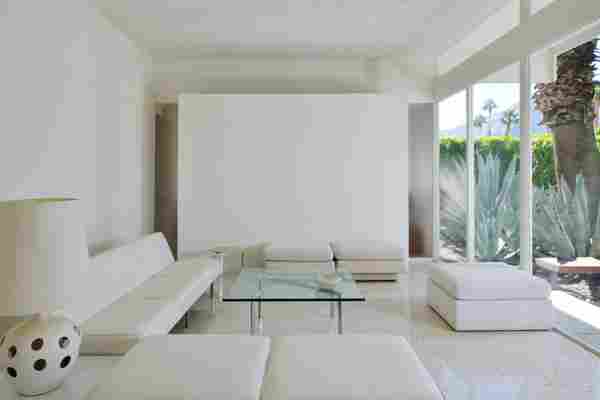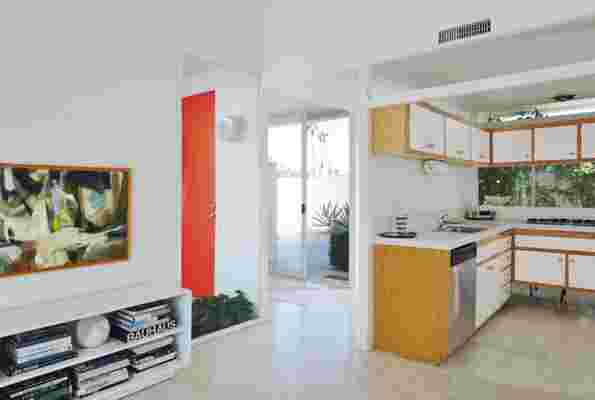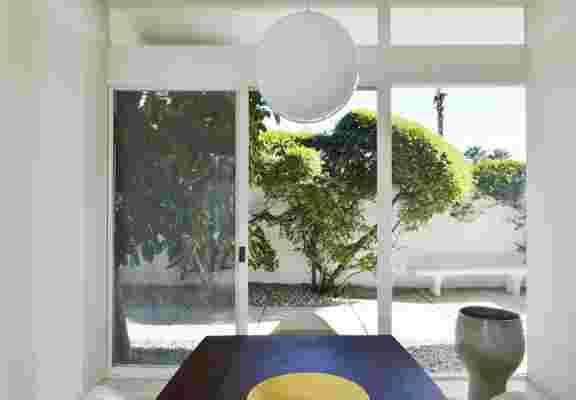You don’t know that you know Jim Moore, but you do. He’s been dressing you—your friends, your dad, your favorite actors, America—for decades. As the creative director of GQ for more than 30 years (he’s been at the magazine since 1979), Moore has been the filter, decider, and guiding hand for much of U.S. menswear during that time. This fall, a measure of that influence will be on display in Hunks and Heroes: Four Decades of Fashion at GQ (Rizzoli) featuring a few hundred of the tens of thousands of photographs Moore has curated for GQ ’s pages. Among those are shots of celebrities (like John Hamm)—who became ciphers for or icons of the culture, with Moore and GQ ’s help—that took place at Moore’s vacation home, a glass-walled Donald Wexler modernist masterpiece, at once utterly humble and astounding, that sits on an arid patch of sun-scorched earth in Palm Springs, California.
“Dimitri Levas, who designed the book, had a great quote about it: ‘There’s a timeless modernity to the work,’” Moore says. It’s a viewpoint that extends to Moore’s home. Built by Wexler in 1962 (original price: $13,000–$17,000), it’s one of seven all-steel prefab houses—a collaboration with U.S. Steel—that were eventually supposed to number 107, until the price of steel rose and the project was abandoned.

Mario Testino used to shoot there a lot. He told me, “Your house is small but you can get a lot done here because the way the light hits it you could use the white walls as a studio and then use the pool for what it is.”
“Donald later admitted to me that he was so soured that the seven homes never turned into 107 homes that he never returned my calls,” says Moore, who reached out to the architect and fellow Minnesotan when he purchased it in 1993. (Eventually, Wexler called him back and they became friends.) “From that day to the day he died, he apologized for that. The recognition of my home [it's been featured in countless editorial and fashion shoots, including the relaunch of House and Garden in 1995] really brought him back to popularity and gave him a boost,” says Moore.
A half-century later, as Wexler’s status as one of modernism’s unsung heroes became acknowledged, the house is on the National Registry of Historic Places and is class-one historical landmarked. “He was a thoughtful architect who loved the commercialization of architecture, loved solving problems, and was never precious about it,” says Moore. “The structures are unsentimental; they’re quite hard-edged. He knows how to place a building on a piece of property, having researched where the sun’s going to hit it.” In the desert, light is everything, and Wexler knew how to harness it.

“I think he was not afraid to admit that he was more engineer than architect. He had a very small ego,” says Moore of the mastermind behind the Palm Springs Airport and decidedly unsexy condominium projects.
Moore’s history with the house dovetails with the history of media. He came to Palm Springs in 1989, on a photo shoot with Mario Testino. At the time, GQ was still using a good deal of models in the magazine, but the tide was turning, and its editor, Art Cooper, was looking more toward celebrities, which put Moore in L.A. a few times a month. “My head was just rubbernecking everywhere,” he says of that trip with Testino. “The town was quiet. I really felt like a tumbleweed was going to roll down Main Street. Hollywood had pulled out in the ’70s. It occurred to me: what a wonderful time to invest in something classic, because for me, the ’80s was when everything was ruined architecturally.”
It was his first home. And it took some convincing. He remembers fashion photographer Dewey Nicks telling him, “Think of it as a really expensive Armani suit. You don’t even have to own it. The bank can own it and you can just live there.” Moore was on the money. Palm Springs was about to have a revival. Around that time, Brad Dunning wrote a piece in Conde Nast Traveler titled “It’s Back, It’s Hot, It’s Palm Springs,” and soon fashion photographers were jostling to shoot at Jim’s house, and then not at his house. Flash forward to 2014: Leonardo DiCaprio was buying Dinah Shore’s old abode—another Wexler build—and Palm Springs had once again become the Hollywood escape it was in its golden era.

“Where my house is positioned—with a wall around it and the view of the mountain—it’s all glass and people are like, ‘I get it.’ I have tons of trees and bushes; it feels warm and inviting because you’re looking outside.”
There’s links to that history in Moore’s house, too. He had heard rumors that it had once belonged to Billy Wilder. One day, an older neighbor getting her mail told him the truth: Wilder had lived there only six months or so, and came seldom, but she’d once seen him in the driveway talking with Katharine Hepburn and Spencer Tracy. At Moore’s house, even the ghosts have pedigree.
While Moore persuaded friends to buy the remainder of Wexler’s seven steel homes, he goes there to escape, not to mingle. He and his partner spend much of their time on the living room couch, looking out at the pool and the mountains, enjoying a small, private space made large by Wexler, who was a student of Richard Neutra.
The bedroom is lit by a glass wall, but also the frosted glass panels of the closet wall, which allow another source of light into the chamber.
“It’s a 1,600-square-foot house. What he learned from Neutra, but also where he stepped away from Neutra, was in the drama: Neutra would give away space for drama. Donald wouldn’t give away an inch of space; he knew how to make every nook and cranny work in a very practical way,” says Moore. The line where Wexler’s practicality meets his genius is visible in a sculptured wall in the living room, which is clearly pushed out quite a bit, with frosted glass panes on either side. Once you enter the bedroom, you realize this wall is also the rear of the closet; it’s been built to give the bedroom, which already has a glass wall, access to another light source.
Moore’s favorite detail? The custom door frames that go to the ceiling. “You ask yourself, Why doesn’t every house have this? Why do doors need to be a standard size? When they go all the way up it creates this infinite line; there isn’t another line that breaks your view, and when the door is open it allows more light in."
“You walk in and think, This is spacious. It’s not. I furnished the house wrong twice. Furniture has to be white and smaller in scale—and nothing on the walls except in the dining room.”
Even when making prefab homes, Wexler and his ilk were thinking of these details. It fits into a tradition that includes the very identity of the city and its geography. “It’s a collection of homes that represents the Hollywood community escaping the press in the ’30s and ’40s, and onwards,” says Moore. “There was as quiet or not so quiet one-upmanship in those times, where everyone wanted the coolest architect to build the most international, modernist house. You have the contrast that is brutal between the arid desert and the palm trees and this really modern structure. They figured it out and it works really well. There’s not a lot of white pickets fences out there. It’s a certain aesthetic.”
Of the seven Wexler steel houses, Moore points out that his is the only truly all-steel model: His neighbors’ sliding doors are aluminum; his are steel. His also features a terrazzo floor. “What Donald did was to have the flooring the same throughout the house. Terrazzo is one of those materials that works in a kitchen, dining room, bedroom, bathroom; if you need some texture you through a rug down.” He never got it out of Wexler if he added these features to show off what a deluxe model could look like, or if they were for Billy Wilder, its first owner, you know, back when people competed not so quietly over the their houses.
“Selfishly, I ended up buying the house because I’m from Minnesota and I never liked going home for Christmas because it’s so frickin’ cold," Moore says, looking back. "I bought it so I could bring my family there for Christmas. I have a picture from the first Christmas there, of my whole family painting the house."
The modern hasn't just surrounded Moore, it's defined much of how he sees the world. “Back in the day, Art Cooper kept wanting to do cinematic sartorial fashion: ‘Let’s do scenes from North by Northwest. ’ That’s not my favorite, because I’m not a nostalgic person. I don’t like to look back. If we did James Bond, I’d make sure the clothes looked timeless, not retro,” he says.
It seems to be a key to Moore’s aesthetic, where his perspective on clothing and photography and architecture align. Maybe he dressed us not by looking at old classics but by creating new ones. “I love midcentury modern architecture because it was always about the future. It was never about the past,” he says. “Maybe that’s my secret sauce.”
